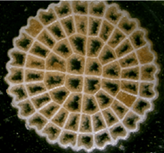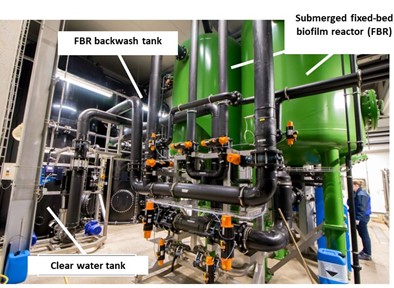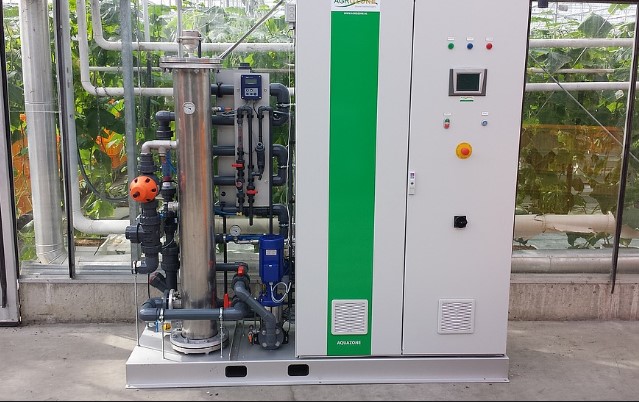Description
The Oldenburg East Frisian Waterboard (OOWV) is a large water supplier in Germany, covering an area of 7,480 km². It provides drinking water from groundwater resources to public, private, industrial, and agricultural customers, and treats wastewater in approximately 50 % of the area. Climate change is causing hotter and drier summers, increasing the demand for water in various sectors (domestic, industrial, and agricultural) and putting more pressure on groundwater resources. The objective of OOWV is to identify untapped water resources and promote the reuse of process water or treated wastewater in water-intensive sectors. The methods and instruments developed in B-WaterSmart will aid in achieving this objective.
Water that is available in large quantities from cheese and dairy product production (COW-water, technology #6) served as an example as an alternative water resource. The aim was to produce high quality water that can be used as process water or be replace drinking water in the food production process. For this purpose, a pilot plant was operated converting whey vapour condensates into process water meeting drinking water standards. The pilot plant on the site of the dairy company DMK Deutsches Milchkontor GmbH included biological and physical treatment steps. The knowledge gained from this study will be used for the design of a large-scale treatment facility, which has the potential to replace more than 50% of the current drinking water demand.
It is essential to consider these technological demonstrations within a broader context to evaluate their contributions to a more resilient and intelligent regional water system. The Urban Water Optioneering Tool (UWOT, tool #22) was used to simulate the water flows (water demand and supply points). It was applied to investigate alternative scenarios based on different climatic and demand change conditions or with the implementation of partially decentralized technologies.
The regional demand-supply matching GIS tool (RDSG #23) was utilized to identify several key aspects: i) potential consumption hotspots and areas experiencing water shortages, ii) alternative water resources or regions with available water sources, and iii) pathways of water transfer from one region to another. This not only helps in pinpointing critical areas needing attention but also aids in strategizing the integration of alternative water sources to ensure a balanced and sustainable water supply across regions.
The short-term demand forecasting tool (STDF, tool #28) was used to generate water demand forecasts for the next or current day. This tool is particularly useful for identifying high peak loads in specific regions, which may necessitate immediate actions by the water utility. By providing accurate and timely forecasts, the STDF helps water utilities to proactively manage demand, ensuring efficient water distribution and minimizing the risk of pressure drops and shortages. Additionally, this tool supports strategic planning and operational adjustments, contributing to a more resilient and responsive water management system.
Applied technologies
Facts of the applied technologies
Capacity: up to 100 m³/h
Production rate or yield: 70-80 m³/h --> 850.000 m³/a
Energy consumption: 1 kWh/m³
CAPEX: ca. 9 Mio € (including plant, civil engineering and electrical engineering)
OPEX: personnel requirements; Energy consumption, chemicals: 0,5 €/m
Key performance indicators
- Drinking water demand before implementation.
- Drinking water demand after implementation of the applied technology.
Synergistic benefits
Pilot plant data from vapor condensate treatment can be incorporated into the water demand-supply tool in a manner that allows for the inclusion of increased industrial reuse through recirculation strategies as a potential future water saving measure on a large scale. This information can then be upscaled to encompass regional water saving potentials for industrial water demands.
UWOT and the Short-term demand forecasting tool are based on a small-scale analysis, while the regional demand supply matching tool is used for large scale analyses. The data flow between the tools can therefore be described in the way that UWOT and STDFT are producing water demand scenarios that can be included in the RDSMG for future-oriented scenarios.
Requirements and conditions
Urban Water Optioneering Tool (UWOT, tool #22):
For the purpose of constructing a baseline model for the testcase, data related to water demand per user (household, livestock, and industry), water supply option and meteorological conditions were estimated. Agricultural data are extracted from CORINE Land Cover (CLC) shapefiles. Other parameters regarding the agriculture, livestock and households are missing and assumptions are included in the model, based on relevant references.
Regional Demand-Supply Matching GIS Tool (RDSMG, tool #23):
No special preparation in the sense of measurement campaigns or the definition of a baseline was required to use the regional demand-supply matching GIS tool in the LL context. A data package including only publicly available information is provided with the tool. Therefore, only some data sets are specific to the LL and needed to be added and were assigned to GIS elements. Since the provision of publicly accessible data by authorities is being increasingly promoted, it is expected that more comprehensive and up-to-date datasets will be available for more regions in the future.
Short-term Demand Forecasting Tool (STDF, tool #28):
To apply the short-term demand forecasting tool in the LL, it was necessary to first deploy flow meters or smart meters that measure hourly water consumption or water flow.
Vapour condensate treatment (COW-water, technology #6):
The following points are important for the implementation of the technology for Vapour Condensate Treatment (COW-water, technology #6):
- Dairy with cheese production
- Knowledge of the quality and quantity of cow water
- Stakeholder management
- Involvement of authorities
Key lessons
Urban Water Optioneering Tool (UWOT, tool #22):
The implementation of the UWOT tool in the test case produced useful results for water use in the different sectors. It could have multiple benefits for water management strategies in case more data becomes available regarding the different water users and sources. Additionally, it could be useful to know the policies and measures related to water management in order to further investigate possible future scenarios based on real data and not assumptions. The model can be adjusted to account for changes in any scenario parameters, (e.g., population increase, livestock changes, industry changes, climate-driven scenarios etc.).
Regional Demand-Supply Matching GIS Tool (RDSMG, tool #23):
The RDSMG tool has the potential to become a key monitoring and decision-making tool for sustainable water resources and water demand management in the region. However, its acceptance and usefulness very much depend on the input data available. For this first-time implementation the main ambition was to make the most use of publicly available information from national, regional, and local databases. In the future, highest benefits from the tool can be derived if data sets are regularly updated and enriched by new information collected from stakeholders.
Short-term Demand Forecasting Tool (STDF, tool #28):
The STDFT was successfully implemented in the city of Lohne. The results of the case study application prove the usefulness and precision of the tool for predicting future load profiles of municipal water demand in the districts under investigation. Nevertheless, the accuracy smart meters in the network and the prognosis depend very much on the positioning of the flow meters (or smart meters), the quality of the data obtained, and demographic information available in this section of the supply network. For future studies a large-scale implementation of smart meters would be desirable instead of summarized measurements of small city districts in order to enhance the prognoses´ quality.
Vapour Condensate Treatment (COW-water, technology #6):
The feasibility of treating water from cheese and dairy product production to drinking water standards has been demonstrated in pilot scale. To ensure water hygiene, any contamination of the clean water side harboring membrane technologies has to be avoided. The biological reactors serving as a first treatment step can potentially harbor hygienically relevant organisms and can be a possible contamination source. The key lesson learnt was to take specific measures prior to realizing large-scale treatment. Measures include thorough disinfection of all surfaces prior to the initial operation similar to drinking water plants. To provide desired microbes with a competitive advantage and to foster the desired biochemical turnovers, a probiotic inoculation of biological reactors using material from similar treatment processes should be considered. Increased microbial competition and occupation of initially free ecological niches will also decrease the risk that hygienically undesired microbes establish.
Lessons learned from technology operation
- The individual production conditions influence the composition of the water from cheese and dairy product production. System operation must be individually optimized to the specific conditions in order to achieve high water and energy efficiency and ultimately economic efficiency.
- Stakeholders (authorities, the public and others) must be continuously involved in the change process.
Legislation and policy recommendations
- Climate Adaptation Strategy & Plans + Circular Economy Action Plan (EU); Water Framework Directive (WFD)
- Federal Water Act (Wasserhaushaltsgesetz, WHG, in German)
- Drinking water Ordinance (Trinkwasserverordnung, TrinkwV)
- Metering Point Operation and Data Communication in Intelligent Energy Networks Act (Gesetz für den Messstellenbetrieb und die Datenkommunikation in intelligenten Energienetzen, MsbG)
- Law on the Federal Office for Information Security (German: Gesetz über das Bundesamt für Sicherheit in der Informationstechnik, BSIG)
- IT Security Act (German: IT-Sicherheitsgesetz, IT-SiG)
Applied products

Urban Water Optioneering Tool
UWOT is a decision-support tool that allows users to compare different water management technologies (including water s…

Short-term demand forecasting tool
Two main components: Backend service that allows to train models and create water demand predictions. The service is r…

Regional demand-supply matching GIS tool
Systematic visualisation and merging of open-source data (water demand and water sources). Identification of water sour…
Publications and references
Schwesig et al. (2023): Digitale Lösungen für eine wasserbewusste Gesellschaft, Energie|Wasser-Praxis, 6+7/2023, pp. 54-59. https://energie-wasser-praxis.de/wp-content/uploads/2023/06/2023_06_06_FB-Schwesig_0607_2023.pdf
In preparation: Gimbel et al. (2024): Short-term forecasting of domestic water demand: model performance of statistic and machine learning algorithms applied to the example of Lohne, Germany. MDPI water.










